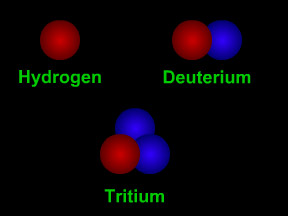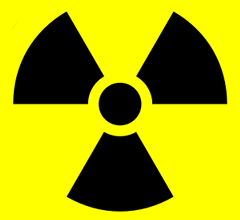This is the international symbol for radiation. If you see this symbol, there are probably radioactive materials nearby.
Click on image for full size
Original artwork by Windows to the Universe staff.
Radioactive
Some materials give off radiation. We call those materials "radioactive". Radioactive materials are often dangerous to people and other living things.
There are many different kinds of radioactive materials. Some give off particle radiation, like alpha or beta particles or neutron radiation. Some give off electromagnetic radiation, such as gamma rays or X-rays.
Most elements come in different "versions", called isotopes. Some isotopes are radioactive. Other isotopes are not. Isotopes that are not radioactive are called "stable" isotopes.
Radioactive isotopes can be dangerous to living things. They can also cause damage to equipment such as electronics. Radioactive isotopes are not always dangerous, though. Some only give off tiny amounts of radiation. There are radioactive isotopes in nature all around us. Most of them cause us little or no harm.
Humans use radioactive materials in many ways. We use them in medicine to treat cancer. We use them to find out how old artifacts are with carbon-14 dating. We also use them for nuclear power and in nuclear weapons.
You might also be interested in:

The text for this level hasn't been written yet. Please check the "Intermediate" or "Advanced" level of this page (click on the bar near the top of this page).
...more
Radiation can be harmful to living creatures. Radiation can harm living things directly by damaging their cells. The cells might stop functioning, or they might be unable to reproduce. Radiation can also
...more
Text for this level has not been written yet. Please see the "Intermediate" text for this page if you want to learn about this topic. To get to the "Intermediate" text, click on the blue "Intermediate"
...more
Text for this level has not been written yet. Please see the "Intermediate" text for this page if you want to learn about this topic. To get to the "Intermediate" text, click on the blue "Intermediate"
...more
An element (also called a "chemical element") is a substance made up entirely of atoms having the same atomic number; that is, all of the atoms have the same number of protons. Hydrogen, helium, oxygen,
...more
Isotopes are different "versions" of an element. All atoms of an element have the same number of protons. All hydrogen atoms have one proton, all carbon atoms have 6 protons, and all uranium atoms have
...more
Radiation can damage electronic circuits. Radiation can also cause electronics to malfunction. Radiation can damage the materials used in electronics over time. That can make the electronics wear out sooner.
...more















